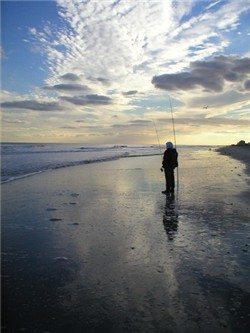| Got Sandbars and Troughs? By Mark Marquez II Based on an interview with Capt. Andy Grossman, owner, Riptide Bait and Tackle, Brigantine |
|||
|
Year after year, the best surf fishing reports in Jersey seem to roll in from one place: Brigantine. Other spots can out-fish the island for a moment, but on the whole, anglers at this Atlantic City neighbor seem to reel in greater numbers of striped bass, blues, drum and other species. “Why is that?” I asked Capt. Andy Grossman, owner of Riptide Bait and Tackle, one of the state's best-known surf-fishing shops. The surf at Brigantine holds more sandbars than other locations, and this creates more troughs, he said. Baitfish swarm those areas, and that's food to fish. Much of the rest of the coast is a steady drop-off without fish-holding structure. Springtime and fall are the best times to surf fish in the state. Those seasons trigger massive migrations of stripers, blues and menhaden that the bass and blues chase. Black drum also make an appearance in spring. The migration of these fish pushes north during spring and south during fall off Jersey. |
||
water temperatures are right. Watch the fishing reports to determine what to toss at any given time. Bluefish usually invade for a period of time during both seasons, and as always will attack nearly anything, including many lures, such as poppers and metal jigs, and baits, especially oily fish like bunker or mackerel. Other fish also turn on from spring through fall, including fluke, kingfish and croakers. Specifics such as exactly how and when to catch each of these fish can be the subject of a whole article in themselves, and tackle shops like Riptide can fill in the holes. Fishing reports can help. But stripers are the main quarry, so a word about rigging for them. Most of Andy’s customers use a fish-finder rig with a 36-inch, 50-pound leader and a 7/0 or 8/0 circle hook. Attach a 4- to 10-ounce weight, depending on seas and current, on the fish-finder. A 4-ounce weight usually holds bottom, but rough seas dictate heavier lead. “Sputnik” or “satellite” weights, with wire prongs that stick in the sand to hold the rig still, are popular. The prongs fold in the opposite direction when the rig is suddenly reeled in, allowing an easy retrieve, and also enabling a lighter weight to be used for the most sensitivity. Impale a surf clam on the hook, throw the rig in the water, and sit back and wait for a hit. For a rod, Andy recommends a Tica Dolphin TC3 as an all-around outfit. A Shimano Tiralejo is a good higher-end rod. A 10-foot length is the minimum, and 10 or 11 feet is usual, but some anglers cast rods up to 13 1/2 feet. Lines from 20- to 30-pound test are common, and many customers throw PowerPro braided line or Suffix braid. Many Brigantine surf fishers use four-wheel-drive vehicles to ply the surf, and permits are required. The permits cost $160 for the season, but cost $60 for ages 60 and older. The permits can be purchased May 1 through September 1 at Brigantine’s Beach Fee Office at 15th Street and Brigantine Avenue from 9 a.m to 4 p.m. During the rest of the year they're available at City Hall at 1417 Brigantine Avenue. Brigantine’s north end, accessible by vehicle, is a hot spot, because Wreck Inlet attracts baitfish on incoming tides. If anglers are walking, Andy recommends the center of the island off the Brigantine Hotel, where a big slough attracts fish. Brigantine’s south end at Absecon Inlet is another go-to location accessible by vehicle, and the pocket at the long jetty there is popular. Being mobile is always helpful in the surf, because it can help anglers find the fish, instead of waiting for them to come to you. Being mobile on foot with a couple of rods and all your gear can be difficult, and sometimes anglers use a surf cart with a cooler rack and rod holders to set up along the beach. Riptide sells them. The store’s staff has sometimes told stories about customers who rig a bicycle to fish the suds. Surf fishing can be one of the most difficult types of fishing to break into, and it can be a long learning curve. Anglers on foot and even in a vehicle can cover less water than on a boat, and that can escalate the importance of fishing properly for success. But like anything that’s challenging, it can be one of the most rewarding types of fishing, because solving the challenge creates learning. Put in the time, was Andy’s advice. Even he racked up a dry spell in the surf for almost 1 ½ months last year before he caught a fish. But the staff at the shop loves beginners, he said, and they’ll help with all advice possible, including showing customers how to tie the knots, even tying rigs. Although the sport can be challenging, there’s also something about the water meeting the land that nearly everyone loves. Like any outdoor experience, the sight of the vast sea beyond the land, incomprehensible, puts life in perspective, often the reason we fish in the first place. The challenge of surf fishing makes advice from others particularly important, shortening the learning curve, eliminating many mistakes that otherwise would take place through a long period of trial and error. When I've spoken with these guys many times through the years, it’s been obvious that they share information. Just take a look back at their reports in the archives. They obviously know the value of helping, so be sure to stop by. |
|||






